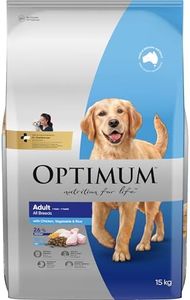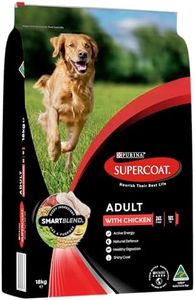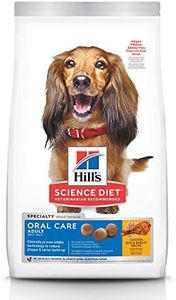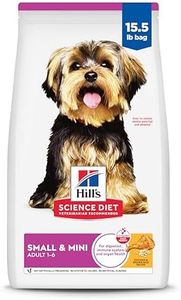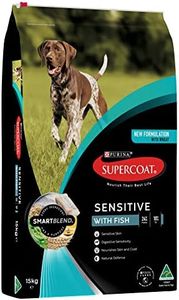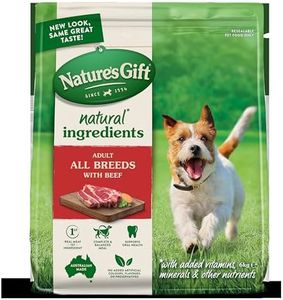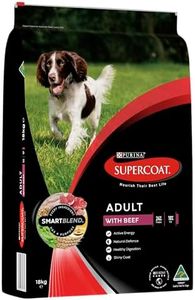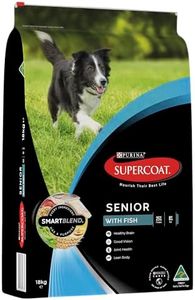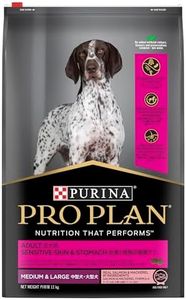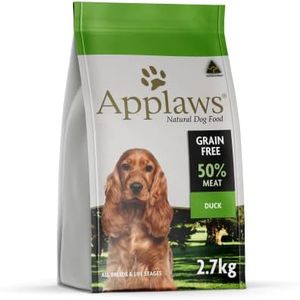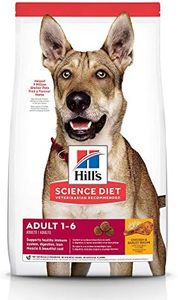We Use CookiesWe use cookies to enhance the security, performance,
functionality and for analytical and promotional activities. By continuing to browse this site you
are agreeing to our privacy policy
10 Best Dry Dog Foods
From leading brands and best sellers available on the web.Buying Guide for the Best Dry Dog Foods
Choosing the right dry dog food can make a big difference in your pet’s health and happiness. It can feel overwhelming with so many bags on the shelf and different claims on the packaging, but focusing on key features will help you find a food that suits your dog’s unique needs. Think about factors like your dog’s age, activity level, size, health conditions, and food sensitivities, and look for foods that meet those requirements. Remember to transition to any new food slowly, mixing it gradually to avoid upsetting your dog’s stomach.Protein Source and ContentProtein in your dog's food supplies essential amino acids needed for muscle, skin, and tissue health. Most dry dog foods use animal proteins like chicken, beef, or fish, while some use plant-based sources. The amount and source of protein can vary, with foods for puppies and active dogs having more protein and foods for senior or less active dogs having less. If your dog is very energetic or still growing, you’ll want higher protein levels, but adult, less active, or senior dogs may do better with moderate amounts. If your dog has allergies, the type of protein also matters, and limited-ingredient diets with a single protein source can help.
Carbohydrates and GrainsCarbohydrates provide energy and fiber, and in dry dog food, they often come from grains (like rice, oats, barley) or grain-free alternatives (like potatoes or peas). Whether you choose grain or grain-free depends on your dog’s digestion and any sensitivities or allergies. Dogs without grain issues can eat either, while those with allergies may do better on grain-free foods. Foods with whole grains offer more fiber and nutrients, while some prefer foods with fewer carbs for dogs with specific health needs.
Fat Content and SourceFat provides energy and supports skin and coat health. The fat level in dry dog foods can range from low (about 8%) for weight control or senior dogs, to high (15% or more) for highly active or working dogs. Check for healthy fat sources like chicken fat or fish oil, as they also provide important omega fatty acids. Pick a fat content that matches your dog's energy needs—active dogs need more, while a less active or overweight dog does better with less.
Life Stage FormulationDifferent age groups need different nutrients: puppies need more protein and calories for growth, adults need balanced maintenance nutrition, and seniors need easier-to-digest, joint-supportive ingredients. Foods will usually be labeled for 'puppy', 'adult', or 'senior', and picking the right one ensures your dog gets age-appropriate support. For example, feeding a puppy adult food might mean missing out on crucial growth nutrients, and vice versa.
Kibble Size and ShapeThe size and shape of the dry food pieces (kibble) affects how easily your dog can chew and digest the food. Small dogs or puppies need small, softer kibble to avoid choking and encourage eating, while large or giant breed dogs benefit from larger kibble that helps slow down feeding and supports dental health. Always pick a kibble size that matches your dog's jaws and eating habits.
Additives and SupplementsMany dry dog foods contain extra vitamins, minerals, probiotics, and sometimes natural additives for joint health or digestion. These added ingredients can support your dog’s skin, coat, immune system, or mobility. Consider foods with supplements if your dog has specific needs, like sensitive skin (look for omega oils) or joint issues (glucosamine or chondroitin). If your dog is healthy and gets regular vet care, basic fortification is usually enough.
Preservatives and Artificial IngredientsPreservatives keep dry dog food safe and fresh, but artificial preservatives, colors, or flavors are best avoided if your dog has sensitivities or you prefer a more natural diet. Look for foods that use natural preservatives like vitamin E or vitamin C (often listed as tocopherols or ascorbic acid). If your dog has had issues with skin or stomach, going for foods with fewer artificial ingredients can sometimes help.
